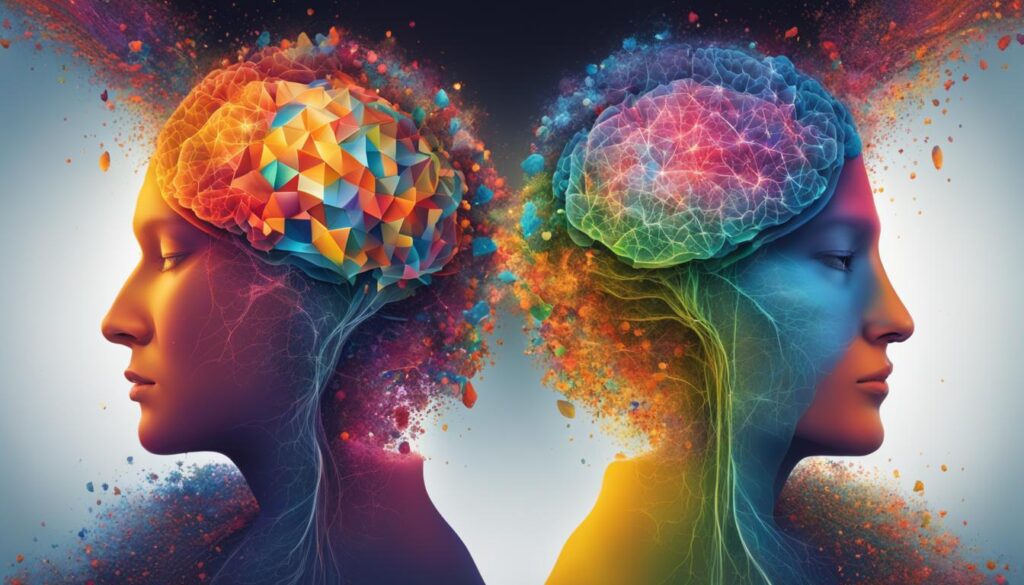When it comes to memory improvement techniques, visualisation is a powerful tool that can unlock the potential of your mind. By harnessing the power of mental imagery, you can enhance your memory and cognitive abilities in remarkable ways. In this article, we explore the fascinating connection between visualisation and memory enhancement.
Key Takeaways:
- Visualisation is a powerful technique that can improve memory recall and cognitive abilities.
- By creating vivid mental images, you can enhance your ability to remember and process information.
- Visualisation techniques can be employed in various aspects of life, including studying, problem-solving, and goal achievement.
- Practicing visualisation regularly can stimulate neuroplasticity, rewiring your brain for improved cognitive function.
- Combining visualisation with other memory techniques, such as association and repetition, can further enhance memory retention.
Defining Aphantasia and its Prevalence
Aphantasia is a condition that affects individuals by impairing their ability to form mental images. It is characterized by the absence or extreme difficulty in visualizing things in one’s mind. Neurologists and researchers have shed light on this condition, revealing that it is more prevalent than previously thought.
Individuals with Aphantasia, also known as Aphantasics, experience challenges when it comes to generating mental images. Unlike those without the condition, they are unable to conjure up vivid pictures or visual memories in their minds. This difficulty in visualizing extends to various aspects of life, including the ability to recall memories, imagine scenes, or even dream visually.
Recent studies suggest that a significant portion of the population may have Aphantasia to varying degrees. While exact prevalence rates are still being studied and debated, researchers estimate that around 2-5% of the population may experience complete Aphantasia, while a larger percentage may exhibit milder forms of the condition.
Aphantasia is a fascinating condition that challenges our understanding of how the mind works. By delving deeper into the definition and prevalence of Aphantasia, we can begin to unravel the complexities of human perception and cognition.
The Neuroscience behind Aphantasia
In individuals with Aphantasia, the mind’s eye operates differently. While most people can easily visualize and generate mental images, those with Aphantasia experience a lack of vivid visual imagery and struggle to recreate images in their minds. The neuroscience behind Aphantasia sheds light on why this condition occurs.
Studies have shown that individuals with Aphantasia exhibit less activation or functional connectivity in the visual cortex, the region responsible for visualization. This reduced activation means that the brain’s visual processing centers are not as engaged during mental imagery tasks. As a result, individuals with Aphantasia have difficulty forming clear and detailed mental images.
Furthermore, weaker connections within imagery networks have been observed in individuals with Aphantasia. These networks involve various brain regions that work together to create and manipulate mental images. The weakened connections make it challenging for individuals with Aphantasia to generate and manipulate visual representations in their minds.
Table: Differences in Brain Activity between Individuals with and without Aphantasia
| Brain Region | Individuals with Aphantasia | Individuals without Aphantasia |
|---|---|---|
| Visual Cortex | Less activation | More activation |
| Imagery Networks | Weaker connections | Stronger connections |
The differences in brain activity and connectivity shed light on the challenges faced by individuals with Aphantasia. It highlights the underlying neurological factors contributing to their difficulty in mental image generation and visualization tasks.
The image above illustrates the brain regions involved in visual processing and their connectivity. While individuals without Aphantasia can effortlessly generate vivid mental imagery, individuals with Aphantasia experience a diminished ability to create clear mental images due to the altered functioning of these brain regions.
Living with Aphantasia and Coping Mechanisms
Living with Aphantasia, the condition that affects your ability to form mental images, presents unique challenges in your daily life. Without the ability to visualize, tasks that require visual imagination can be particularly difficult. However, individuals with Aphantasia have developed coping mechanisms to navigate these challenges and find alternative ways to process information.
One such coping mechanism is relying on verbal descriptions. Without the ability to mentally visualize, you may find that verbal explanations and descriptions become your primary source of understanding and conveying information. Verbal communication skills often become enhanced as you learn to listen attentively and communicate effectively through words.
In addition to relying on verbal descriptions, individuals with Aphantasia often excel in analytical thinking. With a mind less burdened by mental images, you can approach problems and tasks with a clear and logical perspective. Your ability to analyze information without the distraction of visualizations can be a valuable skill in various domains, including problem-solving and critical thinking.
The Challenges of Living with Aphantasia
While Aphantasia can offer unique advantages, it also poses challenges in certain aspects of life. Tasks that heavily rely on visualizations, such as memory recall or creativity in the arts, can be more demanding. Without the ability to mentally recreate images, you may need to rely on alternative memory techniques or find creative ways to express yourself artistically.
Additionally, Aphantasia can impact your experience of certain emotions. Emotions are often tied to visual imagery, and without the ability to visualize, the emotional impact of certain experiences may be different for you. Understanding and navigating these variations in emotional processing can be a valuable aspect of coping with Aphantasia.
| Challenges of Living with Aphantasia | Coping Mechanisms |
|---|---|
| Difficulty in tasks requiring visualizations | Relying on verbal descriptions and alternative sensory cues |
| Memory recall and creativity challenges | Utilizing memory techniques that emphasize associations and emotions |
| Variations in emotional processing | Developing self-awareness and finding adaptive ways to express and understand emotions |
Living with Aphantasia may present challenges, but it also highlights the incredible adaptability and resilience of the human mind. By embracing alternative ways of processing information, leveraging your strengths in analytical thinking, and exploring coping mechanisms tailored to your unique cognitive abilities, you can thrive and live a fulfilling life.
The Aphantasia-Resilience Connection
Living with Aphantasia may present its fair share of challenges, but it also fosters resilience and the ability to adapt. Individuals with Aphantasia have learned to embrace and excel in various domains by developing alternative strategies. Memory techniques that emphasize associations, emotions, or auditory cues become invaluable tools for navigating a world dominated by visual stimuli.
Resilience in Aphantasia manifests in the ability to find innovative ways to overcome obstacles. By harnessing their unique cognitive abilities, individuals with Aphantasia tap into their strengths and find alternative routes to success. The absence of mental images may lead to enhanced verbal communication skills, as they rely on linguistic descriptions to convey their thoughts more effectively.
Moreover, individuals with Aphantasia often excel in analytical thinking. Without the distraction of intrusive mental images, they can focus their cognitive efforts on analysis and problem-solving. This ability can lead to a deeper understanding of complex concepts and a talent for critical thinking.
| Advantages of Aphantasia | Description |
|---|---|
| Enhanced Verbal Communication | Individuals with Aphantasia rely on linguistic descriptions to express themselves, resulting in enhanced communication skills. |
| Analytical Thinking | The absence of mental images allows individuals with Aphantasia to focus their cognitive efforts on analysis and problem-solving. |
| Reduced Intrusive Mental Images | Without the burden of visual distractions, individuals with Aphantasia can maintain a heightened focus on their emotions and experiences. |
| Adaptive Memory Strategies | The absence of mental imagery encourages the development of alternative memory techniques, such as associating information with emotions or auditory cues. |
“Living with Aphantasia has taught me the power of adaptability. While I cannot conjure up mental images, I have developed innovative ways to process information and communicate effectively. My analytical thinking skills have soared, allowing me to excel in problem-solving and critical analysis. Embracing my unique cognitive abilities has empowered me to thrive in a world that values visual imagery. I have discovered that resilience knows no bounds, and I am grateful for the lessons Aphantasia has taught me.”
The Role of Neurocoaching in Aphantasia
Neurocoaching offers a transformative approach to support individuals with Aphantasia in improving cognitive flexibility and developing emotional intelligence. By addressing the unique challenges faced by those with Aphantasia, neurocoaching provides a tailored space for self-reflection and growth.
The process of neurocoaching involves working with a trained coach who specializes in understanding the complexities of Aphantasia. Through guided conversations and exercises, individuals with Aphantasia can explore and develop strategies to enhance their cognitive abilities and emotional well-being.
Neurocoaching for Aphantasia focuses on empowering individuals to embrace their unique cognitive style while also cultivating skills to overcome any limitations. This may include learning techniques to enhance other senses or employing memory strategies that rely on associations or emotional cues.

The Benefits of Neurocoaching for Aphantasia
Neurocoaching allows individuals with Aphantasia to develop a deeper understanding of their cognitive processes and explore alternative approaches to problem-solving and communication. By strengthening cognitive flexibility, individuals can adapt to various situations and improve their overall cognitive functioning.
Additionally, neurocoaching helps individuals with Aphantasia cultivate emotional intelligence, which is crucial for building meaningful connections and navigating relationships effectively. By exploring emotions and developing self-awareness, individuals can enhance their social interactions and improve their overall well-being.
Overall, neurocoaching provides valuable support and guidance for individuals with Aphantasia, empowering them to embrace their unique cognitive style while developing strategies to overcome challenges and thrive in various areas of life.
Advantages of Aphantasia
Having Aphantasia may present challenges in visualizing images, but it also offers unique advantages that can enhance your cognitive abilities and communication skills. Individuals with Aphantasia often excel in verbal communication, relying on descriptive language to articulate their thoughts and ideas with precision. This heightened verbal acuity allows for effective expression and fosters clearer understanding in interpersonal interactions.
Additionally, Aphantasia can cultivate analytical thinking skills. Without the distraction of mental images, individuals with Aphantasia can employ a highly focused and logical approach to problem-solving. This ability to break down complex concepts and analyze information from different angles can lead to innovative solutions and a deeper understanding of various subjects.
Furthermore, individuals with Aphantasia develop alternative memory strategies that rely on associations, emotions, and auditory cues. By harnessing these cognitive tools, they can create unique and adaptive memory techniques that complement their unique perceptual experience. These strategies may involve linking memories to specific emotions or utilizing auditory cues to enhance recall, resulting in a personalized and efficient memory system.
Table: Comparing Communication Skills
| Aphantasia | Non-Aphantasia | |
|---|---|---|
| Verbal Communication | Enhanced | Standard |
| Visual Communication | Challenging | Enhanced |
| Analytical Thinking | Enhanced | Standard |
The table above highlights the comparative advantages of Aphantasia in verbal communication and analytical thinking. While visual communication may pose challenges for individuals with Aphantasia, their strength lies in their ability to excel in other ways, leveraging their unique perceptual experience to achieve success.
The Power of Visualization in Improving Memory
Visualization is a powerful tool that can positively impact memory and cognitive function. By harnessing the innate ability of the mind to create mental images, you can unlock new pathways in the brain and enhance your memory recall. The process of visualizing information helps to solidify neural connections, effectively rewiring the brain to improve memory retention and retrieval.
When you visualize information, you engage multiple regions of the brain, including the visual cortex and imagery networks. This activation stimulates the growth of new neurons and strengthens existing connections, leading to improved memory performance. Through the power of visualization, you can create a vivid and memorable mental representation of the information you want to remember.
Visualizing the details of a concept or event can make it more meaningful and memorable. By mentally picturing the information, you create a deeper level of engagement and understanding.
Research has shown that visualization not only enhances memory but also aids in achieving goals. When you visualize yourself successfully completing a task or reaching a specific milestone, you activate the brain’s motivational centers and increase your chances of success. Visualization can be used in conjunction with other memory techniques, such as association and emotional cues, to create a comprehensive memory improvement strategy.
| Benefits of Visualization |
|---|
| Enhanced memory recall |
| Improved cognitive function |
| Enhanced goal achievement |
| Increased motivation |
| Greater creativity and problem-solving abilities |
Visualization is a valuable tool that can be utilized by individuals with or without aphantasia. Regardless of your ability to create mental images, incorporating visualization techniques into your daily routine can enhance your memory, boost cognitive function, and help you reach your goals.
The Science Behind Visualization
The effectiveness of visualization lies in its ability to activate and engage various regions of the brain. When you visualize, you stimulate the same neural pathways involved in actually experiencing the event or concept, creating a powerful connection between perception and memory. Numerous studies have demonstrated the positive impact of visualization on memory improvement, making it a valuable tool in any cognitive enhancement toolkit.
Conclusion
In conclusion, Aphantasia provides a fascinating insight into the diverse nature of human cognition. While individuals with Aphantasia may face challenges in visualizing mental images, they have developed remarkable coping mechanisms to navigate the world around them. Rather than viewing Aphantasia as a limitation, embracing the diversity of cognition can lead to a greater appreciation for the different ways in which our minds work.
By understanding the neuroscience behind Aphantasia, we can support individuals with this condition in living fulfilling lives. Strategies such as neurocoaching offer a valuable tool for building self-awareness, enhancing cognitive flexibility, and cultivating emotional intelligence. These skills not only empower individuals with Aphantasia to adapt and excel in different domains but also enable them to forge meaningful connections with others.
Furthermore, the power of visualization cannot be underestimated in memory improvement. By using alternative memory techniques that emphasize associations, emotions, or auditory cues, individuals with Aphantasia can still enhance their memory recall and achieve their goals. It is through these approaches that they can unlock their full potential and thrive in a world that celebrates the richness of cognitive diversity.
FAQ
What is Aphantasia?
Aphantasia is the inability or extreme difficulty in forming mental images.
How common is Aphantasia?
Aphantasia affects a significant portion of the population and is more common than previously thought.
What happens in the brain of someone with Aphantasia?
Individuals with Aphantasia show less activation or functional connectivity in the visual cortex, the region responsible for visualization. Weaker connections within imagery networks contribute to the challenges in generating mental images.
How do individuals with Aphantasia process information?
Individuals with Aphantasia develop alternative ways to process information, relying on verbal descriptions, emotions, or other senses.
What challenges do individuals with Aphantasia face?
Individuals with Aphantasia may excel in analytical thinking but face challenges in tasks requiring visualizations.
How can neurocoaching help individuals with Aphantasia?
Neurocoaching provides a space for individuals with Aphantasia to build self-awareness and enhance cognitive flexibility. It can also help them cultivate emotional intelligence.
Are there any advantages to having Aphantasia?
Individuals with Aphantasia may have enhanced verbal communication skills, excel in analytical thinking, and have reduced intrusive mental images.
Can visualization improve memory for individuals with Aphantasia?
Visualization can enhance neuroplasticity, stimulate the growth of new neurons, and create new connections in the brain. It can help improve memory recall and aid in achieving goals.
Is it possible for individuals with Aphantasia to live fulfilling lives?
By understanding the neuroscience behind Aphantasia and employing strategies like neurocoaching and visualization, individuals with Aphantasia can thrive and live fulfilling lives.
Source Links
- https://www.scientificamerican.com/article/can-visualizing-your-body-doing-something-help-you-learn-to-do-it-better/
- https://mentorcruise.com/blog/unlocking-the-inner-world-a-journey-into-aphantasia-and-the-power-of-the-mind/
- https://www.cnbc.com/2019/04/03/deepak-chopra-sanjay-gupta-simple-trick-to-training-your-brain-for-success-according-to-neuroscience.html




